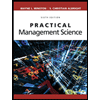
Concept explainers
a)
To determine: The minimum expected cost
Introduction: Expected monetary value is an anticipated value for an investment. The excepted monetary value is computed by multiplying every possible outcome by likelihood of each outcome will occur and summing the all values. Investors use expected monetary values to select the scenario that provides a desired outcome.
b.
To draw: A decision tree.
c.
To determine: The expected value of perfect information.
Expected value of perfect information (EVPI): It is the rate that a person is willing to pay to gain access to perfect information. A common area which uses expected value of perfect information is the healthcare economy. This value tries to evaluate the expected cost of the uncertainty, which can be interpreted as the expected value of perfect information.
Want to see the full answer?
Check out a sample textbook solution
Chapter 5 Solutions
STEVENSON OPERATIONS MANAGEMENT W/CONNEC
- Could you please help identify and explain each of the error(s) in each sentence in the problem statement? Please describe how to address each error. How to rewrite the problem statement, correcting the identified errors. Please see article below Business Problem Information A bank is experiencing a decrease in productivity. Employees appear to be stressed as a result of unmitigated job demands. Bank leaders have tried to address the issues but their efforts have had minimal positive impact. Leaders at the bank, located in Austin, Texas, shared they are struggling to retain employees, and that the employees still present do not seem focused on daily tasks. Employees voiced issues with feedback and low morale. The customer base at the bank has decreased because of rude employees. During research of the peer-reviewed, scholarly literature, it was noted that discovered that bank leaders provided job resources to mitigate job demands which led to an increase in productivity, workplace…arrow_forwardAgree or disagree with post Artificial intelligence provides a means by which revolution takes place as it pertains to the recruitment process and also the staffing development. Understanding how these advancements provide a better way of screening enhances the collaboration as it pertains to dissecting the challenges in the field. HR professionals must be privy to information that will help them to enhance the overall quality of the organization through AI performance. HR professionals providing algorithm fairness or withdrawing from algorithmic bias and discrimination is the first step in goal regarding a recruiting tool pertaining to AI. Having an understanding that historical data to ensure that biases are not perpetuated in the organization is very helpful. HR professionals must understand and have a transparency that takes place as well as it pertains to the recruiting process. In the past there has been a lack of transparency which would lead to legal and ethical…arrow_forwardPlease help.arrow_forward
- Explain how Artificial Intelligence (AI) screening software presents challenges for recruitment and staffing.arrow_forwardCould you please help explain how local initiatives might definitively cooperate job training with economic development purposes?arrow_forwardIf a project cost is only $100 and it's annual benefits are $20/ year, what is the payback period? Question 7Select one: a. 4 Years b. 3 Years c. 5 Yearsarrow_forward
- Generally, a _______ focuses on long-term goals and big-picture objectives, while a ________ deals with the day-to-day details of meeting specific goals. Question 8Select one: a. Leader/ Project Sponor b. Leader/ Manager c. Manager/ Leader d. Team member/ managerarrow_forwardThere are________project management process groups Question 2Select one: a. Eight b. Five c. ten d. Fourarrow_forwardTrue or False: a short payback period is better than a longer one? Question 6Select one: True Falsearrow_forward
 Practical Management ScienceOperations ManagementISBN:9781337406659Author:WINSTON, Wayne L.Publisher:Cengage,
Practical Management ScienceOperations ManagementISBN:9781337406659Author:WINSTON, Wayne L.Publisher:Cengage, Purchasing and Supply Chain ManagementOperations ManagementISBN:9781285869681Author:Robert M. Monczka, Robert B. Handfield, Larry C. Giunipero, James L. PattersonPublisher:Cengage Learning
Purchasing and Supply Chain ManagementOperations ManagementISBN:9781285869681Author:Robert M. Monczka, Robert B. Handfield, Larry C. Giunipero, James L. PattersonPublisher:Cengage Learning

